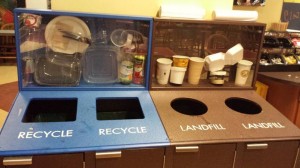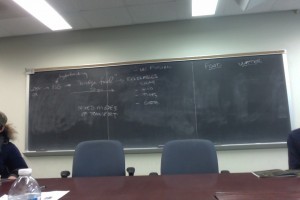Here is a link to a cartoon video teaching us a lesson about our everyday behaviors causing environmental consequences towards the earth.
Month: March 2014 (Page 2 of 4)
Believe it or not, dogs produce more carbon footprint than SUVs. Specifically, a medium-sized dog produces more carbon footprint than a Toyota Land Cruiser. The amount of carbon footprint for a dog is determined by how much it eats. Due to eating a lot of meat, dogs (and cats) have such high carbon footprints. A cat can have a carbon footprint equivalent to a small Volkswagen.
Source: http://www.ecoworld.com/animals/dogs-pollute-more-than-suvs.html
I was in UPenn on 2/9/2014 to attend a memorial service for someone I knew who was a UPenn student who committed suicide on 1/17/2014. While grabbing dinner at the Marketplace prior to the memorial service, I observed this recycle and garbage bins. Right above both bins display actual items that belongs in which bin. Specifically, recyclables are displayed above recycle bins and non-recyclable garbage is displayed above garbage bins.
If you only have time for one of these links, I’d start with the interactive 50-State Roadmap. For each state that you click on, a wealth of stats and info are provided regarding that state’s own route to 100% renewables.
The creator of this roadmap was Dr. Mark Jacobson, a professor of civil and environmental engineering at Stanford University, who believes that this goal is well within our reach if we can just muster the social and political will.
Here are two short articles on Dr. Jacobson from:
Three and a half minute animated bit on “man”. Kind of funny, kind of sad.
The graphite used in lithium ion batteries primarily comes from China and graphite pollution is negatively impacting air and water quality. Unfortunately, lithium ion batteries are vital to many clean electric vehicles in the US, including those manufactured by Tesla.
http://www.bloomberg.com/news/2014-03-14/teslas-in-california-help-bring-dirty-rain-to-china.html
If you have ever walked into a pharmacy like CVS and Rite Aid, you will know what I am talking about. Once I make my purchase, regardless of how much I pay at a time, and how I pay, I will get a really long receipt. It not only is an actual receipt, it also includes coupons and requests to take surveys to enter for a chance to win large sums of cash.
Here is my opinion on this. This is annoying and it is such a waste of paper. I personally throw away receipts anyways and I think these pharmacy chains can do better with saving paper. I know some stores (like Apple retail store and Macy’s) email receipts these days and it is very common for people to get coupons online or via email.
The article by John Fisher on the evolutionary pressures that shape modes of transportation reminded me of this old ad campaign for Suzuki:
It is a shameless advertisement, but it is pretty clever too.
While having conversations with international students who live in south central Asia (India, Pakistan…), one disturbing thing they mentioned is that recycling does not exist in these countries. There are a lot of other issues to focus on. However, I personally think that countries that do have recycling (USA, South Korea…) should bring recycling to those countries; therefore more products would look more sustainable.
This was an interesting history of American car culture, from the late 19th century to today. Although people loved their cars so much due to freedom, one thing that they never thought about: sustainable transportation. Although I personally wished I lived in the earlier days (because of better music, more privacy, etc.), on the other hand, I am happy to live in the 21st century since I can learn about sustainability. Even though I do feel the freedom to travel anywhere with my car, one thing we need to consider is that transportation costs money, regardless of mode. With rising gas prices, I heard words going around that public transportation ridership (including Amtrak) has been going up. Another thing contributing to the increase of public transportation ridership is that driving can cause a lot of traffic.
This article, published in the New York Times, addresses the potential link between fracking and earthquakes occurring nearby. Poland Township in Ohio experienced two earthquakes in one day that were estimated to have originated within less than a mile from a fracking site. Work was halted while it is determined “whether drilling operations induced the earthquakes,” but this isn’t the first time fracking has been tied to earthquakes in the vicinity (Fountain, 4). Fracking has been linked to earthquakes in “Ohio, Arkansas, Oklahoma and other states, and in several countries” in the past (Fountain, 4).
I came across this article in the New York Times regarding a potential expansion of the reach of the Clean Water Act, which may have potentially harmful consequences on farmers with small ditches or streams that have water in them during certain parts of the year.
While arguments for and against this expansion of jurisdiction are made, the consequences aren’t exactly clear. Since assessments of the small ditches and other such water-holding streams would need to be made before the EPA could determine whether a permit is needed, some argue that this would cause farmers to miss out on planting time, which could ultimately lead to great losses of income.
The article is about the various benefits a company can get from using sustainable alternatives, such as employee health and customer satisfaction.
In Copenhagen, Denmark bicycles are the norm and cars are in the minority, 5.2 bicycles for every car. Bikes are actually often the fastest way to get around. Increased biking usage could not only reduce air pollution and greenhouse gas emissions, but also lower people’s risk of developing a number of diseases. This article examines the bike friendliness of several cities around the world and also shows the dangers involved in cycling.
GMOs or genetically modified organisms are a hot topic between the U.S. and the EU. One explanation for the difference in policies toward GMOs in the EU and the U.S. is consumer experience. In the U.S. consumers hold the FDA in high regard and trust their decisions on GMOs while in the EU consumer are more hostile towards GMOs. Many European companies and even Prince Charles made public statements against the use of GMOs which alter public perception. Another explanation is that buffering zones between GMOs and normal crops would be more costly in the densely packed landscape of Europe. In addition, both producers in the EU and in the U.S. now have incentives to maintain their positions on GMOs and lobby their governments. EU farmers would be harmed by eliminating the ban while U.S. farmers would gain. The EU is using the precautionary principle as their defense for their stance. The concept is that the side effects of using GMOs are still unknown so they could have negative health effects on consumers.
This article says there may be health/environmental risks to GMOs
http://rt.com/usa/usda-gmo-risk-report-537/
While this one explains the difference stances the EU and US have on GMOs as a result of culture and trade policy.
13 workers at a nuclear burial site were exposed to an breathed in radioactive material. However it is too soon to see how much health risk this exposure will cause. It shows how every stage of nuclear energy production, even the one we don’t often think about, pose health risks.
The Boyd Gaming Corp. does it again! After earning a LEED silver certification for Boyd Gaming Linen and Uniform Services, it set its sights on becoming Nevada’s first LEED certified arena, the Orleans Arena. Although it was difficult to find specific reforms associated with this gold-level accreditation, which it achieved this week, the Las Vegas Review-Journal had this to say: “Through a variety of measures, the Arena significantly reduced its energy consumption, and reduced the amount of waste sent to local landfills by 25 percent.” Hopefully Boyd Gaming Corp. will soon publish its specific sustainability efforts, but until then I was able to find some info on its silver-certified linen and uniform services. Hopefully more businesses will follow in Boyd’s example to provide sustainable alternatives in Nevada’s tourism and gaming industry.
http://www.8newsnow.com/story/24936301/orleans-arena-receives-major-sustainability-recognition
http://www.usgbcnv.org/resources/Documents/profiles/boyd-linen.pdf
Its interesting to see how bees are portrayed in the media. As someone who is researching the environmental and economic benefit of bees, it is startling to see bees getting a bad rap. These articles are from the last two days and show extreme examples of what can happen when humans come into contact with these insects.
Both bee “attacks” occurred in California. The first, in Palm Desert, details the account of a 71 year old woman who was stung over one thousand times when bees attacked her in her car. The second article, from La Canada Flintridge, details the account of two motorists who were reportedly stung 600 times together after colliding with a tree. These examples can turn public sentiment away from a dwindling, ecological resource. A quote from the LA Times says “Hopefully they are gone for good.” This is frightening because without public awareness as to the benefit of bees, humans will lose a huge contribution from the animal kingdom.
I’ve got a lot of blogging ahead of me so I’d like to pick things up on a light note. This post pertains to my GORP a few weeks ago about the local Chrin Landfill. Although I was previously expressing some concerns about the sustainability of the landfill system, I found some funny guys who might disagree with me. The following comes from Las Vegas entertainers Penn & Teller on their show Bullshit. In this episode they discuss recycling, landfills, and some of the history behind the environmental movement. (Most relevant stuff on landfills comes at the end but the whole thing is pretty funny if you approach the subject with an open mind.)
http://www.youtube.com/watch?v=puVBFIciqGU


Recent Comments